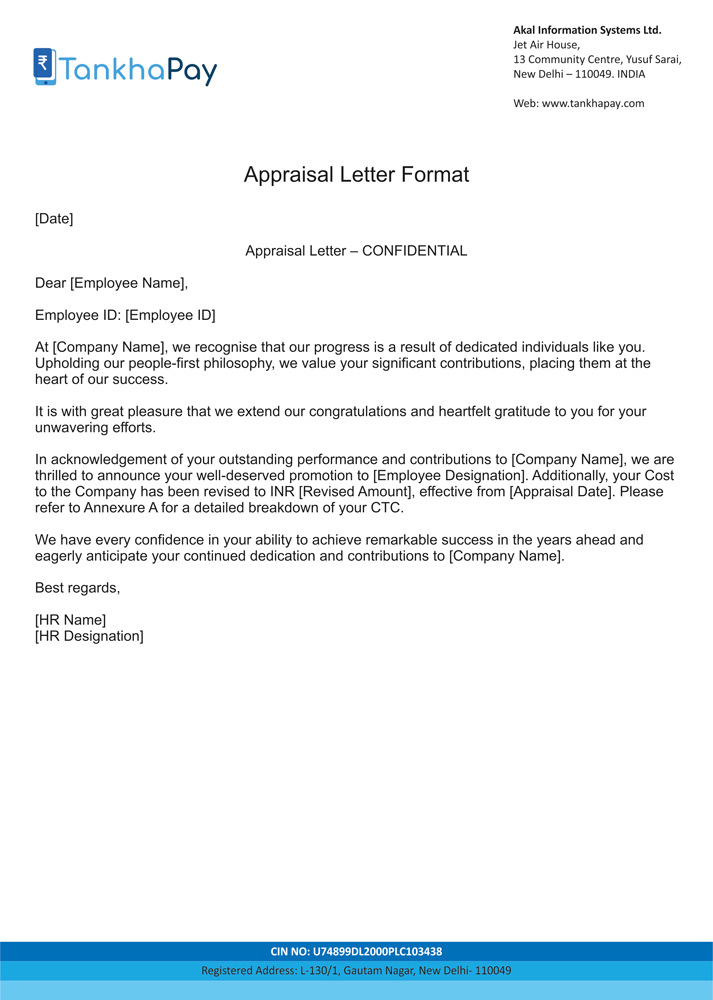Organisations conduct appraisals quarterly, monthly, weekly or annually to systematically evaluate employee performances and the company’s overall contribution. The performance results lead to the issuance of appraisal letters, offering a comprehensive review of employees’ skills, achievements, and areas for growth.
Written by the HR department, appraisal letters are a concrete way to thank staff members for their achievements. They also point out areas of strength and weakness and offer insightful information about their work. These letters also attest to employees’ hard work, boosting morale and serving as a motivational tool.
Essentially, these letters recognise employees’ efforts and acknowledge that their dedication hasn’t gone unnoticed by the upper management, thus encouraging them to strive for even greater performance. Such acknowledgements aim to inspire employees to continue excelling in their roles.
Why Appraisal Letter is important
Appraisal letters are crucial for employers as they recognize and reward employees who contribute to the company’s success, motivating enhanced performance and fostering employee appreciation.
Furthermore, managers can offer guidance on skill development and setting achievable work targets based on the appraisal review. This positive feedback can bolster employee confidence, boost morale, and foster professional and personal growth.
By promoting growth and trust, effective appraisal letters can cultivate a culture of continuous development and dissuade long-term employee discontent.
Types of performance appraisal
The main objective of any performance appraisal review is not much different from the other companies. The main difference lies in the way the employee performance is scrutinised. Let us look at the types of performance appraisals:
Self-Appraisal
Employees utilize self-appraisal to evaluate their own performance, enabling them to have a better comprehension of their professional status within the company. This process facilitates reflection on achievements, areas needing improvement, and overall growth. Engaging in this introspection provides valuable insights into strengths and weaknesses, fostering dialogue between employees and managers during performance reviews. Consequently, these discussions are more meaningful, leveraging the insights gleaned from self-assessment.
360- Degree Appraisal
An employee’s work and input from managers, peers, and subordinates are taken into account while evaluating them using the 360-degree appraisal process. We thoroughly examine mid- or senior-level managers’ competencies, attributes as a leader, and team dynamics. This approach provides a thorough annual performance picture from a variety of angles, prioritizing people management over individual goals.
Manager Performance Appraisal
Managers conduct the Manager Performance Appraisal based on their observations, integrating it with other methods like self-assessment and 360-degree appraisal. During this appraisal, managers discuss your accomplishments and challenges from the evaluation year, aiming to reach a mutual understanding for your appraisal. Together with defining your future goals, you can evaluate your past performance. You and the reporting manager can communicate freely with each other because this method ensures clarity. Talking with your supervisors is also made possible by it.
Critical Components of an Appraisal Letter
While conducting a performance review, analysing a few key areas is essential to make them appealing to the employee and the organisation. A well-crafted appraisal letter should include the following things;
Opening Statement
This sets the tone for the appraisal. It typically expresses gratitude for the individual’s contributions, acknowledges the importance of the review, and briefly highlights the purpose of the evaluation.
Review Criteria
The standard guidelines and expectations of the company against which the individual’s performance is measured. This might include specific goals, competencies, or key performance indicators (KPIs) relevant to the role or organisation.
Performance Assessment
The letter delves into a detailed assessment of the individual’s performance against the established criteria. It includes the employee’s strengths and weaknesses, areas that need improvement and highlighting notable achievements.
Covers critical assessment areas such as communication, teamwork, ability to meet targets, quality of work, attendance, reliability
Analyse and review the employee’s overall contribution and impact to the organisation from the employee.
Analyse and review if they are on the right track of achieving the key objectives.
What improvements can they make to enhance their productivity and achieve objectives more efficiently?
Areas of Improvement
This section concentrates on manager-provided constructive criticism with the goal of increasing employee productivity. It points out areas in which the person’s performance might be improved and provides doable actions or recommendations. To promote growth, this should be delivered in a positive and upbeat way.
Recommendations or Future Goals:
In this section, the letter outlines the individual’s future objectives, development plans, or goals which could include training opportunities, skill development, or specific targets for improvement. It’s essential to align these goals with both the individual’s career aspirations and the organization’s needs in mind.
Closing Statement:
Summarizes the appraisal, reiterates appreciation for the individual’s contributions, and expresses confidence in their ability to improve. The manager give the opportunity for employee feedback and asks for any suggestions or feedback from their side. The manager also encourages open communication for ongoing support and development, thanks the employee for their time and wish them the best.

Appraisal Letter Format
[Your Company Letterhead]
[Date]
[Employee’s Name]
[Employee’s Address]
Dear [Employee’s Name],
This letter to inform you of the recent changes to your compensation package following your performance review.
We are pleased to announce that your salary has been increased from [Previous Salary] to [New Salary], effective [Effective Date]. This adjustment reflects our appreciation for your hard work and dedication.
Your continued contributions are vital to our team’s success, and we look forward to your continued growth within the organization.
If you have any questions or require further clarification, please do not hesitate to reach out.
Sincerely,[Authority Name]
[Authority Title]
[Company Name]
Read More – Salary Increment – Meaning, Format & Samples
Conclusion
The assessment letter serves a crucial role in both rewarding and identifying outstanding work while offering helpful criticism for development. One cannot overstate the proactive importance of this in fostering employee engagement and development. Employers may support a culture of continuous improvement and provide their staff with the resources they need to succeed by using well-written assessment letters in their workforce. Not just a formality, but a strategic investment in the growth of the person and the company, accepting the value of the feedback outlined in these letters.
Visit Also – Boost Your Online Presence with Top-Notch SEO Services in Sheffield
